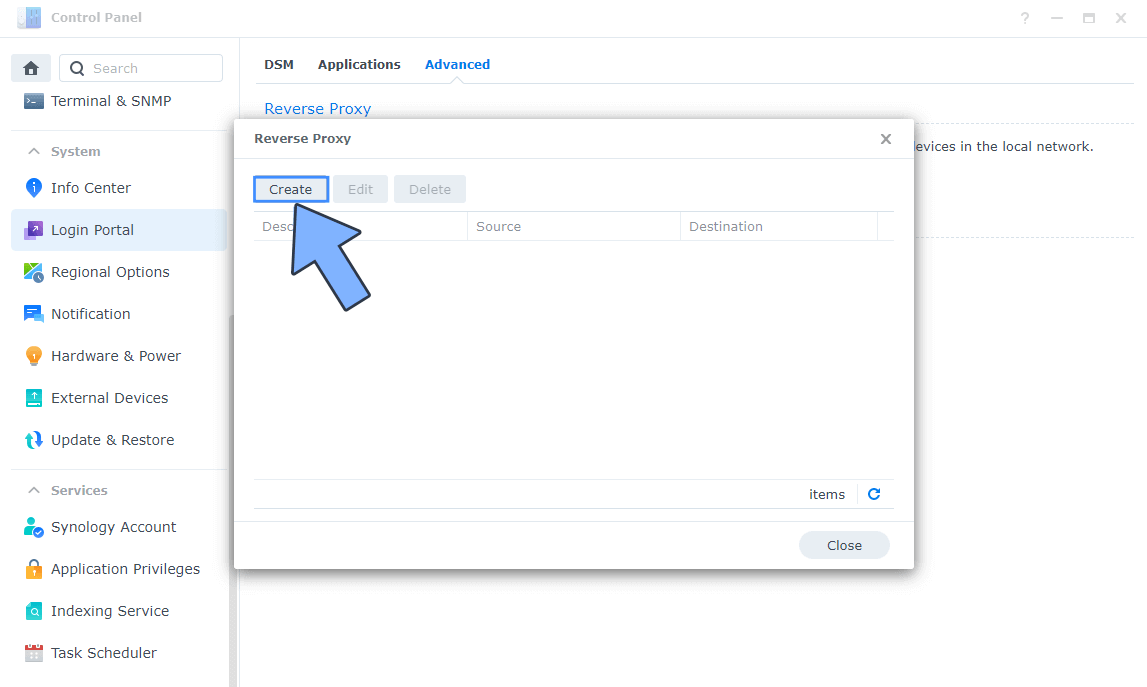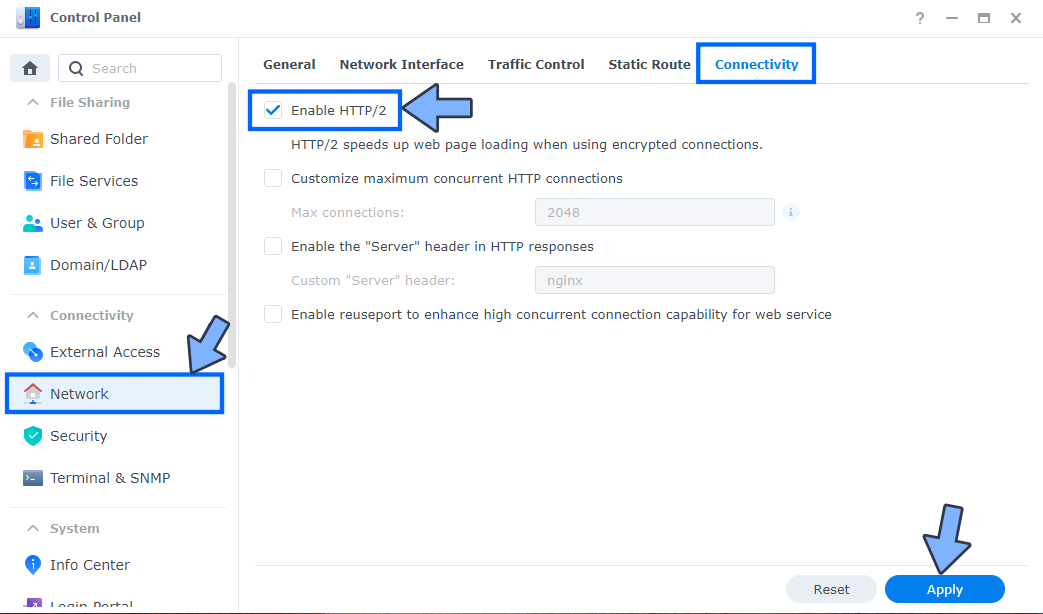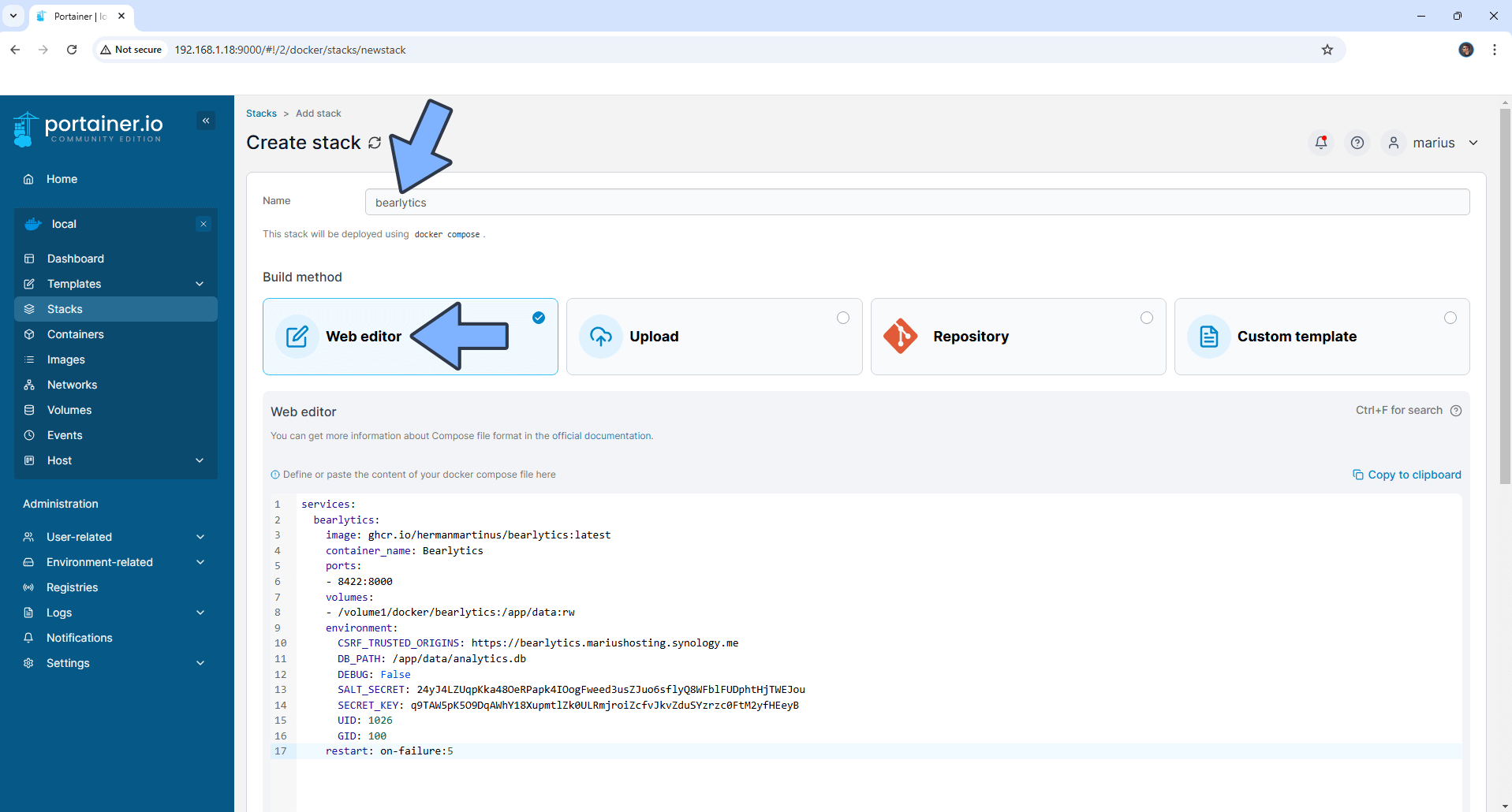
Bearlytics is exactly what it says on the tin – a straightforward web analytics tool that helps you understand your website traffic without selling your soul to the tracking gods. No cookies, no PII problems, just the basics: Page views, Referrers, Country, Device type and Browser. In this step by step guide I will show you how to install Bearlytics on your Synology NAS using Docker & Portainer.
STEP 1
Please Support My work by Making a Donation.
STEP 2
Install Portainer using my step by step guide. If you already have Portainer installed on your Synology NAS, skip this STEP. Attention: Make sure you have installed the latest Portainer version.
STEP 3
Make sure you have a synology.me Wildcard Certificate. Follow my guide to get a Wildcard Certificate. If you already have a synology.me Wildcard certificate, skip this STEP.
STEP 4
Go to Control Panel / Login Portal / Advanced Tab / click Reverse Proxy. Follow the instructions in the image below.

STEP 5
Now click the “Create” button. Follow the instructions in the image below.

STEP 6
After you click the Create button, the window below will open. Follow the instructions in the image below.
On the General area, set the Reverse Proxy Name description: type in Bearlytics. After that, add the following instructions:
Source:
Protocol: HTTPS
Hostname: bearlytics.yourname.synology.me
Port: 443
Check Enable HSTS
Destination:
Protocol: HTTP
Hostname: localhost
Port: 8422

STEP 7
On the Reverse Proxy Rules, click the Custom Header tab. Click Create and then, from the drop-down menu, click WebSocket. After you click on WebSocket, two Header Names and two Values will be automatically added. Click Save. Follow the instructions in the image below.

STEP 8
Go to Control Panel / Network / Connectivity tab/ Check Enable HTTP/2 then click Apply. Follow the instructions in the image below.

STEP 9
Go to Control Panel / Security / Advanced tab/ Check Enable HTTP Compression then click Apply. Follow the instructions in the image below.

STEP 10
Go to File Station and open the docker folder. Inside the docker folder, create one new folder and name it bearlytics. Follow the instructions in the image below.
Note: Be careful to enter only lowercase, not uppercase letters.

STEP 11
Log into Portainer using your username and password. On the left sidebar in Portainer, click on Home then Live connect. Follow the instructions in the image below.

On the left sidebar in Portainer, click on Stacks then + Add stack. Follow the instructions in the image below.

STEP 12
In the Name field type in bearlytics. Follow the instructions in the image below.
services:
bearlytics:
image: ghcr.io/hermanmartinus/bearlytics:latest
container_name: Bearlytics
ports:
- 8422:8000
volumes:
- /volume1/docker/bearlytics:/app/data:rw
environment:
CSRF_TRUSTED_ORIGINS: https://bearlytics.yourname.synology.me
DB_PATH: /app/data/analytics.db
DEBUG: False
SALT_SECRET: 24yJ4LZUqpKka48OeRPapk4IOogFweed3usZJuo6sflyQ8WFblFUDphtHjTWEJou
SECRET_KEY: q9TAW5pK5O9DqAWhY18XupmtlZk0ULRmjroiZcfvJkvZduSYzrzc0FtM2yfHEeyB
UID: 1026
GID: 100
restart: on-failure:5
Note: Before you paste the code above in the Web editor area below, change the value for CSRF_TRUSTED_ORIGINS and type in your own synology.me DDNS with https:// at the beginning that you have previously created at STEP 6.
Note: Before you paste the code above in the Run command area below, change the value for SALT_SECRET. (Generate your own Random 64 length SALT_SECRET.)
Note: Before you paste the code above in the Run command area below, change the value for SECRET_KEY. (Generate your own Random 64 length SECRET_KEY.)
Note: Before you paste the code above in the Web editor area below, change the value numbers for UID and GID with your own values. (Follow my step by step guide on how to do this.)

STEP 13
Scroll down on the page until you see a button named Deploy the stack. Click on it. Follow the instructions in the image below. The installation process can take up to a few minutes. It will depend on your Internet speed connection.

STEP 14
If everything goes right, you will see the following message at the top right of your screen: “Success Stack successfully deployed“.

STEP 15
🟢Please Support My work by Making a Donation. Almost 99,9% of the people that install something using my guides forget to support my work, or just ignore STEP 1. I’ve been very honest about this aspect of my work since the beginning: I don’t run any ADS, I don’t require subscriptions, paid or otherwise, I don’t collect IPs, emails, and I don’t have any referral links from Amazon or other merchants. I also don’t have any POP-UPs or COOKIES. I have repeatedly been told over the years how much I have contributed to the community. It’s something I love doing and have been honest about my passion since the beginning. But I also Need The Community to Support me Back to be able to continue doing this work.
STEP 16
Now open your browser and type in your HTTPS/SSL certificate like this https://bearlytics.yourname.synology.me that you have previously created at STEP 6. In my case it’s https://bearlytics.mariushosting.synology.me Type in the default Username and Password, then click Sign In. Follow the instructions in the image below.

STEP 17
Add the name of your website. Copy the Bearlytics tracking code. You will need this tracking code at STEP 18. Click Dashboard to monitor your website. Follow the instructions in the image below.

STEP 18
Paste your personal Bearlytics Tracking code script that you have automatically generated at STEP 17 on your website between the <head> and </head> tags of your site, then update your file. For example, I have a WordPress website hosted on a Synology NAS. If you have a WordPress website hosted elsewhere, know that the process is the same. Log into your WordPress admin Dashboard, click on the left sidebar on “Theme File Editor“, under Appearance. Select your theme then search for the header.php file. Paste your personal Bearlytics Tracking code script in the header.php file between the <head> and </head> tags of your site, then update your file. Follow the instructions in the image below.
Note: You can add multiple websites via the Bearlytics Dashboard later.

STEP 19
Now open your browser and type in your HTTPS/SSL certificate like this https://bearlytics.yourname.synology.me/admin/ that you have previously created at STEP 6. In my case it’s https://bearlytics.mariushosting.synology.me/admin/ At the top right of the page, click CHANGE PASSWORD to change the default admin password of your Bearlytics instance.

STEP 20
Your Bearlytics dashboard at a glance!

Enjoy Bearlytics! My blog doesn’t have any TRACKING CODE on it. I just installed Bearlytics to show you how it works and how easily you can implement it on your website. I have already uninstalled it. Don’t forget to go back to STEP 1.
If you encounter issues by using this container, make sure to check out the Common Docker issues article.
Note: Can I run Docker on my Synology NAS? See the supported models.
Note: How to Back Up Docker Containers on your Synology NAS.
Note: Find out how to update the Bearlytics container with the latest image.
Note: How to Free Disk Space on Your NAS if You Run Docker.
Note: How to Schedule Start & Stop For Docker Containers.
Note: How to Activate Email Notifications.
Note: How to Add Access Control Profile on Your NAS.
Note: How to Change Docker Containers Restart Policy.
Note: How to Use Docker Containers With VPN.
Note: Convert Docker Run Into Docker Compose.
Note: How to Clean Docker.
Note: How to Clean Docker Automatically.
Note: Best Practices When Using Docker and DDNS.
Note: Some Docker Containers Need WebSocket.
Note: Find out the Best NAS Models For Docker.
Note: Activate Gmail SMTP For Docker Containers.
This post was updated on Wednesday / August 27th, 2025 at 1:26 AM
